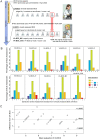Inter-evaluator bias and applicability of feline body condition score from visual assessment
- PMID: 40901064
- PMCID: PMC12400680
- DOI: 10.3389/fvets.2025.1604557
Inter-evaluator bias and applicability of feline body condition score from visual assessment
Abstract
Body Condition Score (BCS) is an effective tool for assessing body weight and fat mass, as well as diagnosing obesity and abnormal weight loss. A method for visual assessment of BCS in cats would be useful to expand access for feline health and research. The goal of this study is to determine whether BCS can be accurately assessed solely from photographs of cats, and to measure inter-evaluator bias in visually assessed BCS. To do this, a set of online-sourced cat images was administered as a quiz to nine evaluators. Inter-evaluator bias was relatively low (mean ± SE = 0.35 ± 0.03) with ~50% complete agreement. To validate the results, a BCS was clinically assessed during routine wellness exams for 38 cats, enrolled, through palpation by one evaluator and visual assessment by all nine evaluators using photographs collected at the exam. The visual assessment of BCS deviated from the clinically assessed BCS by 0.61 ± 0.04, which was slightly higher than the deviation observed in the online-sourced image set. In both scenarios, the majority voting among all evaluators achieved the highest accuracy, demonstrating its effectiveness in reducing evaluator bias. Inter-evaluator bias caused a 15.5% misclassification between ideal and overweight BCS but 1.8% between ideal and obese, indicating minimal bias in diagnosing feline obesity. The ability to accurately assess BCS through photographic evaluation will enhance remote consultations in telemedicine and support large-scale epidemiological studies. This study has developed a method for evaluating and minimizing inter-evaluator bias in BCS assessments across diverse practitioners and settings, thereby improving consistency and comparability and improving our understanding and application of BCS as a tool for feline health.
Keywords: body condition score; body weight; domestic cat; obesity; palpation; telemedicine.
Copyright © 2025 Graff, Lea, Delmain, Chamorro, Ma, Zheng, Zhang, Brinker, Kittell, Hicks, Pfister, Hamilton, Li, Martin and Wang.
Conflict of interest statement
The authors declare that the research was conducted in the absence of any commercial or financial relationships that could be perceived as a potential conflict of interest. The author(s) declared that they were an editorial board member of Frontiers, at the time of submission. This had no impact on the peer review process and the final decision.
Figures





Similar articles
-
Prescription of Controlled Substances: Benefits and Risks.2025 Jul 6. In: StatPearls [Internet]. Treasure Island (FL): StatPearls Publishing; 2025 Jan–. 2025 Jul 6. In: StatPearls [Internet]. Treasure Island (FL): StatPearls Publishing; 2025 Jan–. PMID: 30726003 Free Books & Documents.
-
[Volume and health outcomes: evidence from systematic reviews and from evaluation of Italian hospital data].Epidemiol Prev. 2013 Mar-Jun;37(2-3 Suppl 2):1-100. Epidemiol Prev. 2013. PMID: 23851286 Italian.
-
Comparison of Two Modern Survival Prediction Tools, SORG-MLA and METSSS, in Patients With Symptomatic Long-bone Metastases Who Underwent Local Treatment With Surgery Followed by Radiotherapy and With Radiotherapy Alone.Clin Orthop Relat Res. 2024 Dec 1;482(12):2193-2208. doi: 10.1097/CORR.0000000000003185. Epub 2024 Jul 23. Clin Orthop Relat Res. 2024. PMID: 39051924
-
A New Measure of Quantified Social Health Is Associated With Levels of Discomfort, Capability, and Mental and General Health Among Patients Seeking Musculoskeletal Specialty Care.Clin Orthop Relat Res. 2025 Apr 1;483(4):647-663. doi: 10.1097/CORR.0000000000003394. Epub 2025 Feb 5. Clin Orthop Relat Res. 2025. PMID: 39915110
-
Signs and symptoms to determine if a patient presenting in primary care or hospital outpatient settings has COVID-19.Cochrane Database Syst Rev. 2022 May 20;5(5):CD013665. doi: 10.1002/14651858.CD013665.pub3. Cochrane Database Syst Rev. 2022. PMID: 35593186 Free PMC article.
References
LinkOut - more resources
Full Text Sources
Miscellaneous

